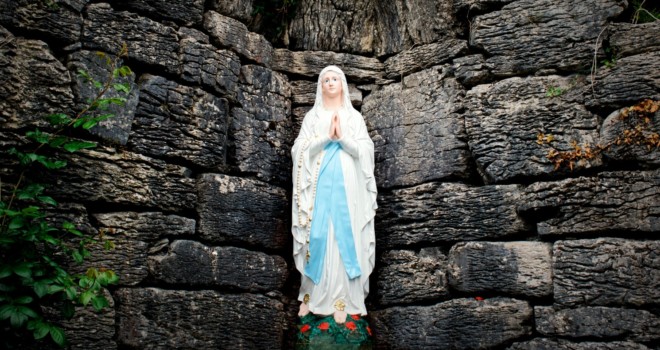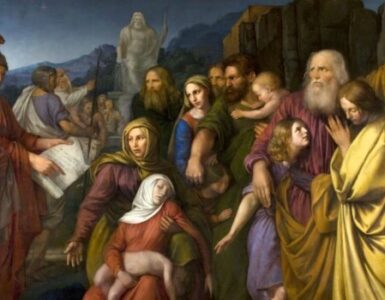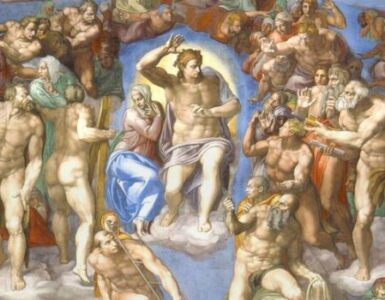On June 1, 2019, the city of Amsterdam was the place of an international meeting of “Prayer for Peace through the Advocacy of Mary, Mother of all Peoples.” For Protestant Christians, it can be difficult to understand Catholic devotion to Mary. In an interview for Mother of All Peoples, we asked the Bishop of Amsterdam, Bishop Jozef Maria Punt to explain the Church’s devotion to Mary.
First of all, Bishop, can you make clear who Mary is within a Catholic understanding?
As Catholics and Protestants together, we honor Mary as the Mother of Christ. All her dignity, all her greatness, comes from him, and from him alone. We agree on that. To fully understand who she is, therefore, we must first take a closer look at him.
He is the Son of the Father, “the Son of the Most High”, as the Archangel called him during the Annunciation to the Virgin Mary. She was called to become his mother, an election of dizzying proportions. “From now on, all generations will call me blessed,” Mary rejoiced in her song of praise. Therefore, first we must correctly understand how unjust and unworthy it would be to look at Mary as a kind of “surrogate mother,” a woman the Father needed so that his Son could be born, and after that she could just go. That’s even undignified behavior for men, not to mention for God. If we really believe that Jesus Christ is the true Son of God, as both Catholics and Protestants do, we must acknowledge that there is a unique relationship between the Triune God and this young woman, a relationship that lasts forever. That’s why Catholics call her: ‘Daughter of the Father, Mother of the Son, Bride of the Holy Spirit.”
How do you explain that in the Bible, Jesus refers to his mother just “Woman”?
Indeed, at central scenes, like Cana and Golgotha, the Lord calls his Mother: ‘Woman’. This is often misunderstood, as if he wanted to take some distance from her, and even a kind of disrespect. The opposite is true. “Woman” was a name of honor in the original Paradise. In Genesis, it was Adam and “the woman.” The name “Eve’”only came after the Fall: Eve, who once was “the Woman”, but who also lost this dignity.
The Lord honors his mother as the new Eve, who corrected the sin of Eve. Mary in Scripture is now the “Woman” again. That’s what he declared on the Cross. Jesus gave his life, his blood, his everything, for the remission of our sins. With his last words, words with the power of a testament, He also gave his Mother: “Woman, behold your son… behold your Mother.” As Catholics we believe that this not only is meant as a practical message for John, but as Jesus’ last wish, that all his disciples would take her as their Mother, a real spiritual Mother. She is a creature, for sure, but as Spouse of the Holy Spirit, totally enveloped by him, she is made capable for this, her universal mission. As the sacrifice of Christ was for all humanity, we honor Mary as the Mother of all humanity, of all peoples.
You state that Mary “corrected the sin of Eve.” Can you explain that further?
I have to begin with God’s plan of Creation. In Colossians 1:16, St. Paul writes in his hymn about Christ: “…in him everything is created, in heaven and on earth, visible and invisible… the universe is created by him and because of him…”. We must understand Creation from the perspective of the Incarnation, and not the other way around. St. John Paul II states it very clearly in the first sentence of his first encyclical, Redemptor Hominis, “Christ is the center of the universe and of history.” Before all times, the eternal God, humanly speaking, planned the Incarnation of his Son. He created all the universe to bring forth a created nature, man, whom he would give all his love, whom he would raise to the childhood of God. For that reason, Christ was born.
But, of course, the Father could only conceive the Incarnation of his Son along with the Woman, from whom his Son would take flesh. And nowadays through science, we know better what flesh means: not only muscles, bones etc., but all his DNA, his “gene cart,” his whole human potential and qualities. Besides his divinity and his human soul, all else came from Mary, and from her alone. As Mother Teresa put it simply: “No Mary, no Jesus.” Therefore, in Catholic understanding, Mary could not be a sinful being. Original sin also affects our DNA. By the grace of God, a grace derived in advance from the Redemption, she was therefore created in the original purity and original freedom, not yet corrupted by sin. We call it “the Immaculate Conception’.” It had to be that way.
Only in that true freedom, in the name of all humanity, Mary could say “yes” to God, where Eve said “no,” and by this free act, and by her free suffering with Christ from birth to death, she corrected the sin of Eve, and became the “cause of salvation for herself and the whole human race,” as the Church Father, St. Irenaeus writes as early as the second century. Her “yes” is just as crucial in the history of mankind as the “no”of Eve. As Eve cooperated with Adam in sin, Mary cooperated with Jesus in Redemption. Of course, Christ is our sole divine Redeemer, but in the human sense, Mary truly deserves to be called Co-redemptrix with Jesus, not only because she is his Mother, but again, because she is the Immaculate Conception.
Mary certainly had an important place in God’s plan of salvation. But why do we need her now? Why do Catholics pray to a human being and not directly to Jesus Christ?
We, of course, pray directly to Jesus all the time, and to the Father and to the Holy Spirit, but it is very biblical to also invoke the intercession of other humans to pray for us. In Luke 7, for instance, we read how the Roman centurion asked Jesus to heal his servant, who was very dear to him. Jesus answered his prayer. He healed the servant, not because of the servant’s faith, but because of the faith and the prayer of his master. In the same way, the daughter of the Canaanite woman was healed, not because of her faith – she even was under the power of evil spirits – but because of the prayer and the faith of her mother. And so we can go on.
What a tremendous power the advocacy and the prayer of Mary must have, the Mother of Jesus, when she pleas for us with her Son, as she did at Cana. But, of course, many Protestant Christians will say, at Cana she was still alive, but now Mary is dead. No, she isn’t! That is heresy. When on the Mount Tabor, Moses and Elijah appeared at the Transfiguration of the Lord, where did they come from? They, of course, are alive in the spiritual realm, waiting for the day of the Resurrection, when they and all who died in Christ will be clothed with a new spiritual and imperishable body, as St. Paul calls it. The first Christians fully understood this. In the persecutions of the first centuries, they wrote the names of their martyred and murdered loved ones on the walls of the catacombs: “Felicitas, pray for us… Claudius, help us…” And again, we believe, the advocacy of Mary is the most powerful. As the new Eve and the Mother of the Christ, she already shares in the glorification of her Son in body and soul.
Where do you find the scriptural foundation for Catholic Mariology ?
We must first delve a little bit deeper into the relationship between Scripture and Tradition. Together with our Protestant brothers and sisters, we consider holy Scripture the true Word of God. But the Bible did not fall from Heaven. It originated within the Tradition of the Church. Guided by the Holy Spirit, the Magisterium of the early Church selected the writings, letters and gospels they considered authentic and inspired, that make up the Bible as we know it today.
We believe the Holy Spirit keeps guiding the Church to attain in time an ever deeper understanding of Scripture. As the Lord explained it himself in John 16:12, “Much I still have to say to you, but at present you cannot take it. But when He comes, the Spirit of Truth, He will bring you to the full truth.”
There are many texts in the Bible that are not immediately clear, and can easily lead to different interpretations, as the thousands of Protestant denominations clearly show. The concept of a Trinitarian God, for instance, is not explicitly formulated in the Bible, but only indicated. It needed time and inspiration for the Church to enter more deeply into the mystery that God is not alone, but that a Trinitarian love and relation exists within himself: one Nature, three Persons.
Also, Mariology is essentially found in Scripture. We can look at the Annunciation, at Cana, at Golgotha and Pentecost, but in a more hidden way also at Genesis and the book of Revelation. The concept of Mary as the New Eve came about already in the earliest days of Christianity. All later Mariology is nothing else then the further development of this concept, and of her being the Mother of the incarnate Son of God. Two thousand years ago, people were not ready to comprehend the full greatness of Mary, although briefly indicated in Scripture, due also to the low appreciation of women in that time.
Here too, theology needed time, but the heart led the way much more quickly. The first Christians painted the image of Mary and the Child on the walls of the catacombs. Already in the third century we find a Marian prayer on papyrus in Egypt: ‘Under your protection, we take our refuge, holy Mother of God…” With many Catholics I believe the Lord awaited our time, a time in which the evil one strongly manifest himself, to reveal the full greatness of Mary, as “the Woman, clothed with the Sun.”
What then, in your opinion, is the special importance of Mary for our time?
On the Cross Jesus Christ gained full victory over Satan, Redemption for all people of all times. But this Redemption has to come about in time and history. Here, Mary plays a crucial role, as the new Eve and the spiritual Mother of all humanity. In Genesis 3:15 God says to the serpent, ‘I will put enmity between you and the woman…’ This image stands at the beginning and at the end of holy Scripture. Creature against creature. In Genesis it is the serpent, the dragon, that gains victory over Eve. In Revelation the roles are reversed. Here, it is the new Eve, ‘the Woman, clothed with the Sun’, who gains victory over the dragon. In this vision of John from the book of Revelation, we recognize the Church, but primarily Mary, like the early Fathers of the Church did. As the dragon rises in our times, so too must the Woman.
For two thousand years the Lord came on this earth humble and hidden, only recognized by the lowly of heart. Also Mary, his mother, acted in humility and silence, her true greatness hidden for the world, even for his disciples. Before He comes again in glory, so St. Louis Marie Grignon de Montfort tells us, He will first make his Mother great. The Mother always precedes the Son. She will bring Him and his Cross back in our modern world.
Protestants long and work for what they refer to as a “New Awakening.” What do Catholics think about that, and where do you see Mary in relation to it?
In this point, we fully agree, but only use different words. We, however, think Mary has a great role in receiving this new outpouring of the Holy Spirit, this “New Pentecost” or “New Awakening,” if you wish. If we honor Mary in the true greatness the Lord has granted her, so we believe she can fully exercise her maternal power over the Heart of her Son, like at Cana, and lead him to change water in wine in our present time— to bring us the Holy Spirit again and anew. That’s the essential message of the Amsterdam apparitions 70 years ago. That’s why millions of faithful and hundreds of bishops request a new and last Marian dogma. The last three popes prayed for such a “new Pentecost.” Many prophetic voices in our time predict such an event. This inspiration is not against the Bible. We can connect it with biblical prophecies, like Joel, several Psalms, etc.
At the same time, we can all see the danger of a world catastrophe happening in our time if many people do not respond to these graces, or fall back later. Nevertheless, I believe the Holy Spirit will come, not because we deserve it, but because we need it so much. This is, after all, how God is. “Where sin abounds, grace abounds more,” Scripture promises. When the Lord comes in the power of his Spirit, he will reveal the immense love of God, but also the evil of our time and in our own hearts. He will show how our indifference to the poor, the sins against life, especially unborn life, against the dignity of man and the honor of God, wounds his Heart. Only from such an illumination of conscience, which in a way we already see the first dawn, can come repentance, conversion and peace.
Now is the time of spiritual preparation, a time of waiting for the Lord to come in the power of his Spirit, a time for persistent prayer with and around Mary, like before the first Pentecost. In Amsterdam, she gave a short and timely prayer that calls for the Holy Spirit to come:
“Lord Jesus Christ, Son of the Father, send now your Spirit over the earth. Let the Holy Spirit live in the hearts of all Peoples, that they may be preserved from degeneration, disaster and war. May the Lady of all Nations, the Blessed Virgin Mary*, be our Advocate. Amen.”
She put special emphasis on ‘now’. It is a strong prayer, directed to our Lord Jesus Christ, that we therefore as Catholics and Protestants can pray together.
✠
Photo by Grant Whitty on Unsplash
This article originally appeared on The Marian Library of Mother of All Peoples and appears here with kind permission.












